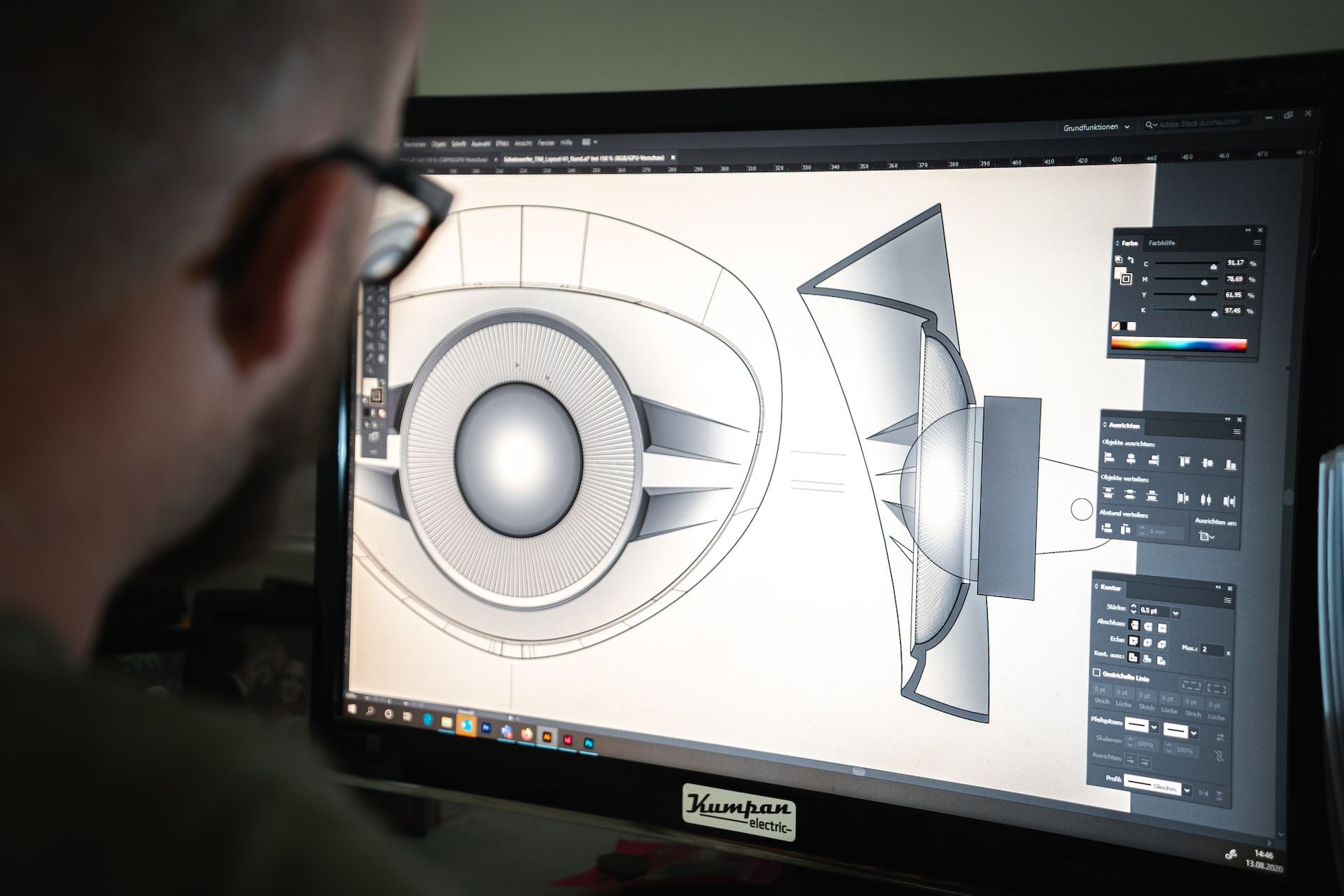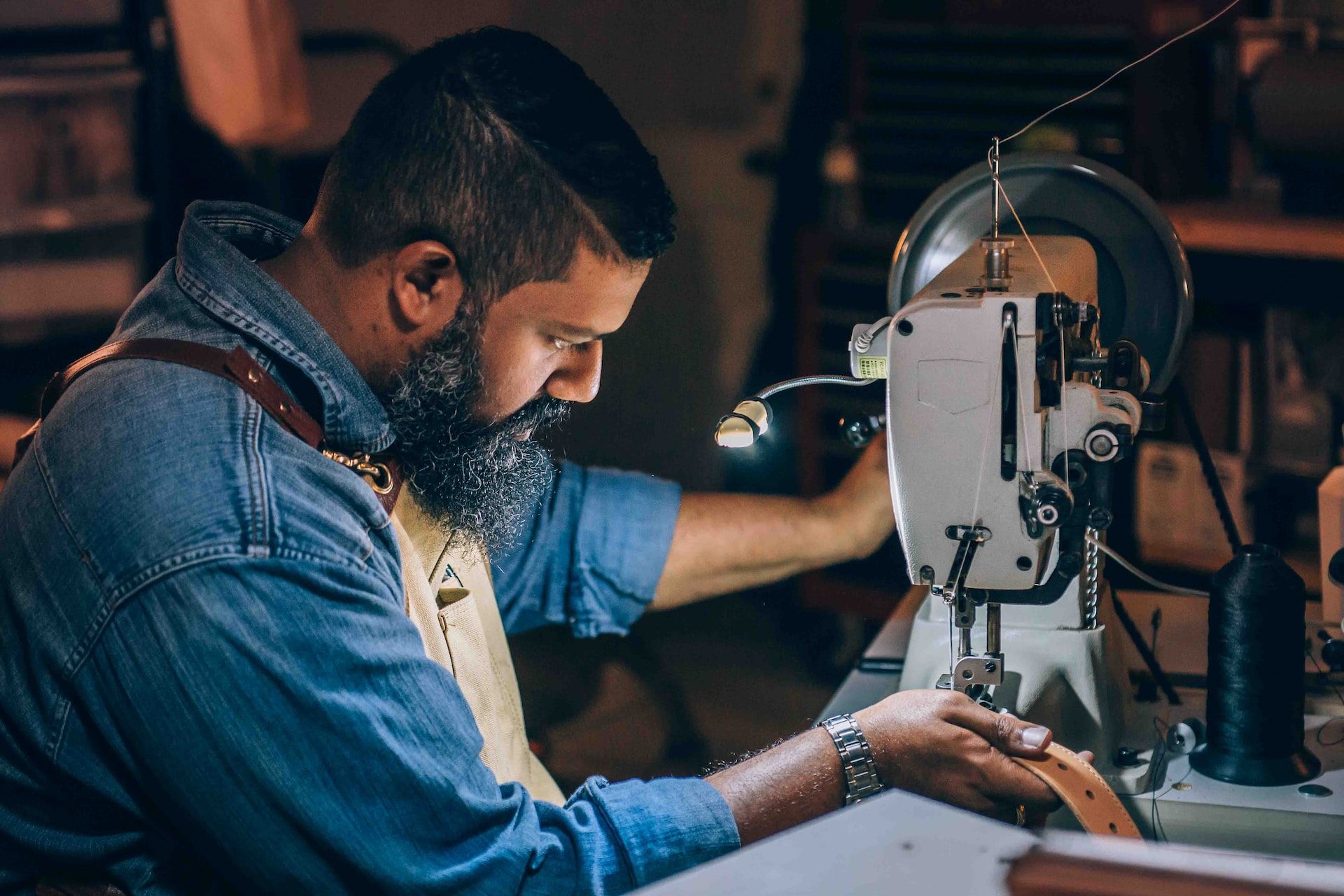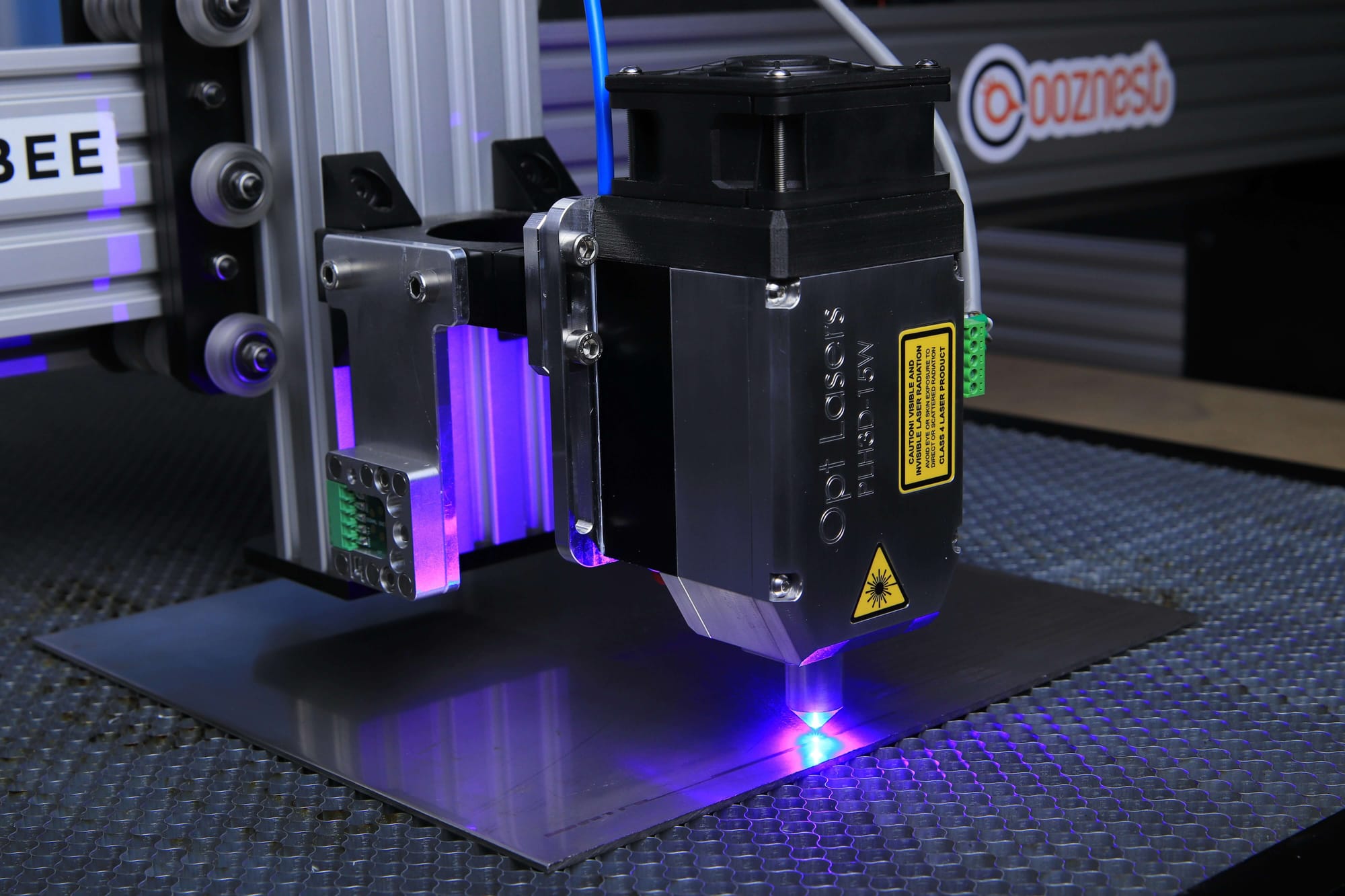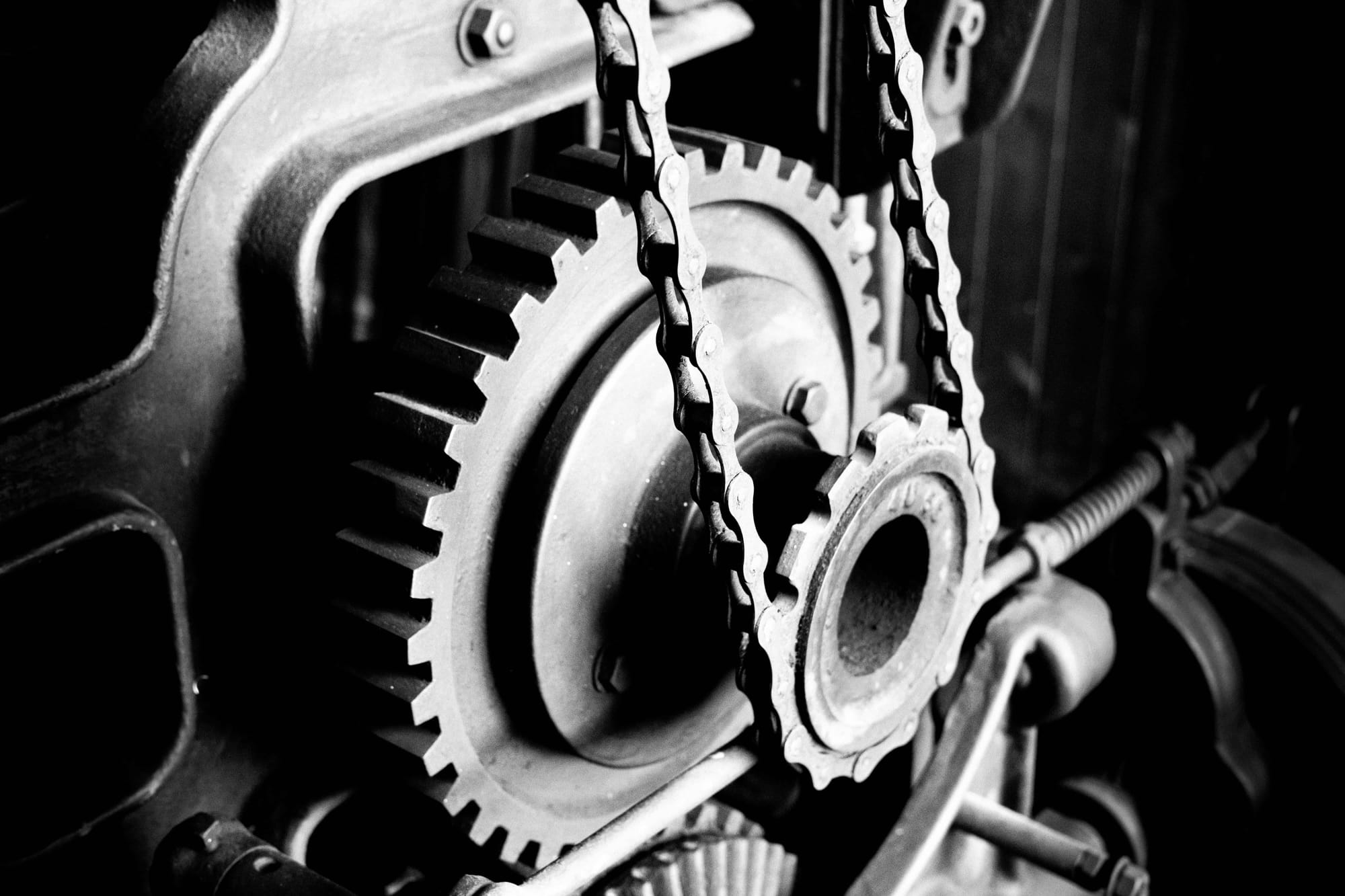Leather has been a staple material for centuries, used in various industries from fashion to automotive. However, the leather production process can be time-consuming and expensive, which can impact the profitability of businesses that rely on this material.
According to a report by Grand View Research, the global leather market size was valued at $41.2 billion in 2020 and is expected to grow at a compound annual growth rate (CAGR) of 5.4% from 2021 to 2028.
To remain competitive in today's market, leather manufacturers must constantly seek ways to improve efficiency and streamline their production processes. Streamlining production processes can help businesses reduce costs, improve product quality, and meet customer demand more effectively.
By identifying areas where inefficiencies exist and investing in modern equipment and technologies, leather manufacturers can automate processes, reduce material waste, standardize processes, cross-train employees, and implement quality control measures to streamline their production processes.

In this article, we will explore some tips and strategies that can help leather manufacturers streamline their production processes, optimize resource usage and raw material inventory, and remain competitive in the industry.
- Importance of Leather Production Processes
- Analyzing Current Production Processes
- Investing in Modern Equipment and Technologies
- Automation of Processes
- Reducing Material Waste
- Standardization of Processes
- Cross-Training of Employees
- Quality Control Measures
- Monitoring and Measuring Progress
- Advantages of Implementing an MRP System for Effective Leather Production
- How can Deskera Help You?
- Key Takeaways
- Related Articles
Importance of Leather Production Processes
Leather production processes are essential for the leather industry, which is a significant contributor to the global economy. The leather industry provides employment opportunities to millions of people worldwide and generates billions of dollars in revenue annually. The leather produced from these processes is used in various industries, including fashion, automotive, furniture, and upholstery, among others.
Efficient leather production processes are crucial for the industry's sustainability and competitiveness. Streamlining these processes can help manufacturers reduce costs, optimize resource usage, and improve product quality. It can also help meet customer demand more effectively and quickly, allowing for increased sales and profitability.
Moreover, sustainable and environmentally responsible production processes are gaining importance in the leather industry. Adopting eco-friendly practices can help leather manufacturers reduce their carbon footprint, minimize waste, and promote environmental stewardship. Efficient leather production processes can also help businesses meet compliance requirements and standards, reducing the risk of fines and penalties.
In summary, efficient and sustainable leather production processes are essential for the industry's success, profitability, and sustainability.
Analyzing Current Production Processes
Before leather manufacturers can streamline their production processes, they need to assess their current processes. Analyzing current production processes can help identify areas where inefficiencies exist and determine which processes can be improved or eliminated.
To analyze current production processes, leather manufacturers can take the following steps:
- Map out the production process: Identify all the steps involved in the leather production process, from raw material sourcing to finished product delivery. Create a flowchart or process map to visualize the process and identify potential bottlenecks or inefficiencies.
- Analyze each step: Analyze each step in the production process to determine which processes are essential, which ones can be eliminated, and which ones can be improved. Identify areas where time is wasted, quality is compromised, or errors occur.
- Collect data: Collect data on production processes, including cycle times, downtime, and defect rates. Analyze the data to identify patterns or trends that may indicate inefficiencies.
- Seek input from employees: Involve employees who work directly with the production processes. They may have valuable insights and suggestions for improving production processes based on their firsthand experiences.
By analyzing current production processes, leather manufacturers can identify areas that need improvement, prioritize changes, and create a plan for streamlining production processes. This process can lead to increased efficiency, reduced costs, and improved product quality.
Identifying Current Inefficiencies and Bottlenecks
Identifying inefficiencies and bottlenecks is a crucial step in streamlining leather production processes. Inefficiencies are any aspects of the production process that waste time, money, or resources, while bottlenecks are any points in the production process that slow down or impede the overall production flow.
To identify inefficiencies and bottlenecks, leather manufacturers can take the following steps:
- Conduct a process walkthrough: Observe the production process in action to identify any areas where inefficiencies or bottlenecks exist. This can help identify any steps that take too long or cause delays.
- Analyze production data: Collect and analyze data on production processes, including cycle times, downtime, and defect rates. This data can help identify bottlenecks in the production process and inefficiencies that need to be addressed.
- Talk to employees: Discuss production processes with employees who work directly with the processes. They may have valuable insights into areas that need improvement or suggestions for streamlining the process.
- Use process mapping: Create a process map to identify areas where the process flow slows down or bottlenecks occur. This can help identify areas where production processes can be improved.
This process can lead to increased efficiency, reduced costs, and improved product quality.
Evaluating the Overall Production Workflow
The production workflow includes all the processes and steps involved in creating a product from start to finish.
To evaluate the overall production workflow, leather manufacturers can take the following steps:
- Identify the steps involved: Map out all the steps involved in the production process, from raw material sourcing to finished product delivery.
- Analyze each step: Analyze each step in the production process to determine which ones can be improved or eliminated. Identify areas where time is wasted, quality is compromised, or errors occur.
- Determine dependencies: Identify which steps are dependent on each other, and which steps can be performed concurrently.
- Optimize the workflow: Once the production workflow has been analyzed, optimize it to reduce waste and improve efficiency. This may involve eliminating non-value-added steps, improving material handling, or reorganizing the production layout.
By evaluating the overall production workflow, leather manufacturers can create a more efficient and streamlined process. This process can lead to reduced production time, increased throughput, and improved product quality.
Investing in Modern Equipment and Technologies
New technologies can help leather manufacturers automate and optimize their production processes, reducing waste, improving quality, and increasing throughput.
To invest in modern equipment and technologies, leather manufacturers can take the following steps:
- Research available options: Research the latest equipment and technologies available in the market and identify those that best suit the specific needs of the business.
- Assess costs and benefits: Evaluate the costs and benefits of the new equipment and technologies to determine if the investment is financially viable. Consider factors such as reduced labor costs, increased production efficiency, and improved product quality.
- Determine compatibility: Determine if the new equipment and technologies are compatible with existing production processes, and if any modifications or upgrades are required.
- Plan for implementation: Develop a plan for implementing the new equipment and technologies, including training for employees, scheduling downtime, and testing the new processes.
By investing in modern equipment and technologies, leather manufacturers can improve their production processes and remain competitive in the market. These investments can help reduce costs, increase efficiency, and improve product quality.
Introduction of New Technologies that Can Help in Streamlining Leather Production Processes
The introduction of new technologies has transformed the leather manufacturing industry, offering innovative solutions to streamline production processes and improve product quality. Leather manufacturers can take advantage of the latest technologies to automate manual processes, reduce waste, and increase efficiency.
Some of the new technologies that can help in streamlining leather production processes include:
- Computer-aided design (CAD) software: CAD software allows designers to create detailed 3D models of leather products, reducing the time and costs associated with manual pattern making.
- Laser cutting machines: Laser cutting machines offer precise and efficient cutting of leather, reducing material waste and improving product consistency.
- Automated leather grading systems: These systems use advanced imaging technologies to automatically grade leather hides, improving accuracy and reducing labor costs.
- Radio frequency identification (RFID) tagging: RFID tagging enables the tracking and management of leather hides throughout the production process, providing real-time visibility and reducing the risk of errors.
By embracing these new technologies, leather manufacturers can streamline their production processes, reduce costs, and improve the quality of their products. The adoption of these technologies can also help manufacturers remain competitive in an increasingly global and rapidly evolving industry.
Benefits of Investing in Modern Equipment
Investing in modern equipment for leather production processes can offer numerous benefits to manufacturers. Here are some of the key benefits:
- Increased efficiency: Modern equipment is designed to optimize production processes, which can significantly increase efficiency and productivity. This can lead to faster turnaround times, reduced labor costs, and increased profitability.
- Improved quality: Modern equipment is often equipped with advanced features that can improve the quality of leather products. For example, laser cutting machines offer precise and consistent cutting, which can reduce the risk of errors and improve the quality of finished products.
- Reduced waste: Modern equipment is designed to minimize waste and maximize material usage. This can reduce the cost of materials and improve sustainability by reducing the environmental impact of the production process.
- Enhanced safety: Modern equipment is often equipped with advanced safety features, such as sensors and alarms, which can reduce the risk of accidents and injuries in the workplace.
- Competitive advantage: By investing in modern equipment, leather manufacturers can differentiate themselves from competitors, improve their reputation, and attract new customers.
Automation of Processes
Automation of processes involves using machines and technology to perform tasks that were previously done manually by human operators. In the context of leather production, automation can involve using machines for tasks such as cutting, sewing, and finishing.
By automating these tasks, manufacturers can significantly improve the speed and efficiency of their production processes, reducing the time it takes to complete each task and increasing overall output. Additionally, automated machines can perform tasks with a high degree of accuracy and consistency, reducing the risk of errors and inconsistencies in the production process.
This can lead to higher quality finished products. Another benefit of automation is the ability to collect real-time data on production processes, which can be used to identify inefficiencies and areas for improvement. Overall, automation can help leather manufacturers optimize their production processes, reduce costs, and improve the quality and consistency of their products.
Benefits of Automation in Leather Production Processes
Automation in leather production processes can bring a wide range of benefits to manufacturers, including:
- Increased Efficiency: Automated machines can perform tasks much faster than humans, which can reduce production time and increase output.
- Consistency and Accuracy: Automated machines can perform tasks with a high degree of accuracy and consistency, reducing the risk of errors and inconsistencies in the production process. This can lead to higher quality finished products.
- Cost Reduction: Automation can help reduce labor costs, which can help to lower overall production costs and increase profitability.
- Enhanced Safety: Automated machines can perform tasks that are hazardous for humans, such as cutting and punching, reducing the risk of accidents and injuries in the workplace.
- Real-time Data Collection and Analysis: Automation can enable the collection of real-time data on production processes, which can be used to identify inefficiencies and areas for improvement.
- Improved Productivity: Automation can help to optimize production processes and workflows, reducing bottlenecks and increasing overall productivity.
- Flexibility: Automated machines can be programmed to perform a wide range of tasks, making it easier to adapt to changing production demands and requirements.
Areas where Automation can be Implemented to Streamline Processes
There are several areas in leather production processes where automation can be implemented to streamline workflows and improve efficiency. Some of these areas include:
- Cutting and Trimming: Automated cutting machines can accurately and efficiently cut leather into various shapes and sizes, reducing waste and increasing efficiency.
- Sewing and Stitching: Automated sewing machines can perform stitching tasks with precision and speed, reducing labor costs and improving consistency in finished products.
- Finishing: Automated machines can be used for finishing processes such as polishing and buffing, ensuring a consistent and high-quality finish on leather products.
- Material Handling: Automated material handling systems can move leather materials and products between different stages of the production process, reducing the need for manual handling and improving efficiency.
- Quality Control: Automated inspection systems can be used to detect defects and inconsistencies in leather products, improving quality control and reducing waste.
- Inventory Management: Automated inventory management systems can track materials and products in real-time, ensuring that the right materials are available when needed and reducing the risk of shortages or overstocking.
Overall, automation can be implemented in various stages of leather production processes, from cutting and stitching to finishing and quality control, to streamline workflows and improve efficiency.
Reducing Material Waste
Reducing material waste is an essential step in streamlining leather production processes. Leather production generates a significant amount of waste, including scraps and leftover materials, which can increase production costs and impact the environment. To reduce material waste, leather manufacturers can implement various strategies, such as:
Accurate Cutting: Precise cutting of leather materials can reduce waste by minimizing the amount of excess material generated. Automated cutting machines can accurately cut leather into various shapes and sizes, ensuring minimal waste.
Efficient Material Handling: Proper handling of materials can reduce waste by minimizing damage to the leather. Automated material handling systems can move leather materials and products between different stages of the production process, reducing the risk of damage.
Recycling and Reusing: Unused leather scraps and leftover materials can be reused or recycled. These materials can be used to create smaller leather goods or repurposed into other products, reducing the amount of waste generated.
Streamlining Processes: By streamlining production processes, leather manufacturers can reduce the amount of time and materials required to complete each task. This can be achieved by implementing automation, reducing manual labor, and improving process efficiency.
Overall, reducing material waste is a critical step in improving the efficiency and sustainability of leather production processes. By implementing strategies such as accurate cutting, efficient material handling, recycling, and streamlining processes, leather manufacturers can minimize waste and improve profitability.
Identifying Areas where Material Waste Can Occur in the Production Process
One of the critical steps to reducing material waste in leather production processes is to identify the areas where it can occur. There are several common areas where material waste can be generated in the leather production process. One of these areas is during the cutting process.
When cutting the leather into different shapes, sizes, and patterns, there may be scraps and offcuts of leather generated. This waste can be minimized by optimizing the cutting process and using efficient cutting tools and equipment.
Another area where waste can occur is during the trimming process. After the leather is cut, it may require trimming to remove any rough edges or uneven parts. In this process, excess leather may be trimmed, leading to waste. By optimizing the trimming process, it is possible to minimize the amount of leather waste generated.
Furthermore, during the assembly and finishing stages, waste can also occur. Excess glue, thread, and other materials may be used, leading to waste. By using the right amount of materials and optimizing the finishing process, it is possible to reduce the amount of waste generated.
Overall, identifying the areas where material waste can occur is essential in reducing waste and improving efficiency in leather production processes.
Strategies to Reduce Material Waste and Optimize Resource Usage
Reducing material waste and optimizing resource usage is critical to streamlining leather production processes. Here are some strategies that can be employed to achieve this:
- Implementing Lean Manufacturing principles: Lean manufacturing is a systematic approach that aims to eliminate waste and optimize resources in production processes. By applying lean principles in leather production processes, companies can identify and eliminate non-value-adding activities, reduce inventory, and optimize the use of resources.
- Using efficient cutting tools and equipment: To minimize material waste generated during the cutting process, it is essential to use efficient cutting tools and equipment. Automated cutting machines, for instance, can cut leather with high precision, reducing the amount of scrap generated.
- Optimizing the trimming process: By optimizing the trimming process, it is possible to reduce the amount of leather waste generated. This can be achieved by using efficient trimming tools and equipment, reducing the amount of excess leather trimmed, and reusing scraps of leather where possible.
- Using eco-friendly materials: Using eco-friendly materials such as vegetable-tanned leather or recycled leather can reduce the environmental impact of leather production and minimize waste generation.
- Recycling and reusing waste: Leather waste can be recycled and reused to make other products such as wallets, belts, and bags. Companies can also explore the possibility of selling scrap leather to other industries that use leather as raw material.
Standardization of Processes
In the context of leather production, standardization can involve creating guidelines for tasks such as leather cutting, stitching, and finishing. This ensures that each task is performed consistently, reducing the likelihood of errors, inconsistencies, and material waste.
Standardization of processes can be achieved through various means, such as creating visual aids and checklists, providing training to workers, and implementing quality control measures. By standardizing processes, leather manufacturers can achieve greater efficiency, consistency, and quality in their products. This can also make it easier to identify and resolve issues that may arise during the production process.
Additionally, standardization can help to streamline the training process for new employees, as they can be quickly taught the standardized procedures rather than relying on individual experience or expertise. Standardization can also help to improve communication among workers, as they all have a shared understanding of how tasks should be performed. Overall, standardization can play a crucial role in optimizing leather production processes and improving the overall efficiency of the manufacturing operation.
Importance of Standardizing Processes for Efficiency and Quality Control
Standardization of processes refers to creating uniformity and consistency in procedures and tasks that are carried out during the leather production process. This involves creating a set of guidelines and protocols that are followed by everyone involved in the process. Standardizing processes is important because it helps to improve efficiency and quality control.
When processes are standardized, workers know exactly what is expected of them and how to perform their tasks. This reduces the likelihood of errors, reduces the time taken to complete tasks and ensures that the final product meets the desired quality standards.
Standardization also makes it easier to identify areas where improvements can be made in the production process. This enables managers to develop better ways of carrying out tasks and to eliminate unnecessary steps.
Strategies to Standardize Processes Across the Production Workflow
Standardizing processes across the production workflow involves developing a set of guidelines and protocols that are followed by everyone involved in the process. Here are some strategies that can be used to standardize processes:
- Develop a detailed process map: Creating a process map that outlines every step in the production process can help to identify areas where standardization is needed.
- Develop standard operating procedures (SOPs): SOPs provide a step-by-step guide for workers to follow when carrying out tasks. This ensures that everyone is following the same procedures.
- Train workers: It's important to ensure that all workers are trained in the standard operating procedures and that they understand how to follow them.
- Use visual aids: Visual aids such as diagrams and flowcharts can be used to make the standard operating procedures more accessible and easier to follow.
- Implement quality control measures: Quality control measures such as regular inspections and testing can help to ensure that the standard operating procedures are being followed correctly.
- Monitor and evaluate: Regular monitoring and evaluation of the standard operating procedures can help to identify areas where improvements can be made and ensure that the procedures are still relevant and effective.
By implementing these strategies, standardization of processes can be achieved across the production workflow, leading to improved efficiency, consistency and quality control.
Cross-Training of Employees
Cross-training of employees is the practice of teaching workers to perform tasks outside of their designated job roles. It is an effective way of creating a flexible workforce that can adapt to changing business needs.
In leather production processes, cross-training can help prevent bottlenecks and reduce downtime caused by employee absenteeism or skill gaps. Cross-training employees can also lead to increased job satisfaction, employee engagement, and productivity. It provides opportunities for employees to learn new skills and expand their knowledge, leading to career advancement and personal growth.
Cross-training also allows for smoother transitions between job roles and helps in promoting teamwork and collaboration among employees. By implementing cross-training programs, companies can optimize the use of their workforce, increase their operational efficiency, and ultimately improve their bottom line.
Importance of Cross-Training Employees for Increased Flexibility and Efficiency
Cross-training employees refers to the process of teaching employees the skills required for various roles and responsibilities within the organization. In the context of leather production, cross-training can be a valuable strategy to improve flexibility and increase efficiency.
When employees are trained in multiple areas, they become more versatile and can adapt to changes in production demand. This means that they can be moved from one area of production to another, as needed, without compromising the quality or quantity of the output.
Cross-training also helps to foster a culture of teamwork and collaboration within the organization. Employees who understand the challenges and requirements of different roles are more likely to appreciate the contributions of their colleagues and work more effectively as a team. Additionally, cross-training can provide employees with new and diverse skills that can enhance their professional development and job satisfaction.
By investing in employee training and development, organizations can reap the benefits of a more versatile and skilled workforce, leading to improved production outcomes and increased profitability.
Strategies for Implementing Cross-Training Programs
Cross-training programs enable employees to learn multiple skills, which increases their versatility and makes them more valuable to the company. Cross-training also helps to prevent bottlenecks in production and allows for seamless transitions between different stages of the production process.
One strategy for implementing a cross-training program is to start by identifying the key areas where cross-training is most needed. This could involve analyzing the production workflow to identify bottlenecks or areas where there is a high demand for skilled labor. Once these areas are identified, employees can be selected for cross-training based on their existing skills and job roles.
Training programs can then be developed to teach employees new skills and give them the opportunity to practice them under the guidance of experienced trainers. It is important to provide ongoing support and feedback to ensure that employees are able to develop their skills and apply them effectively in the workplace. Regular assessments and performance reviews can also help to ensure that the cross-training program is delivering the desired results.
Quality Control Measures
Implementing quality control measures involves identifying the critical points in the production process where errors or defects can occur. This is followed by setting up procedures and standards that will help prevent errors or defects from occurring. Quality control measures can be achieved through inspections, testing, and audits to verify that the product meets the required quality standards.
There are various quality control techniques that can be employed in leather production, such as statistical process control, which involves measuring and analyzing production data to identify any deviations from the established standards. This information is then used to make adjustments to the production process to ensure consistency and quality. Other quality control measures include visual inspections, testing of raw materials, and audits of the production process.
Implementing quality control measures helps to minimize defects, reduce waste, and ensure that the final product meets the customer's specifications. By maintaining consistent quality, leather manufacturers can establish a good reputation for their products, attract new customers, and retain existing ones.
Importance of Quality Control in Leather Production Processes
Quality control measures help to detect defects and prevent faulty products from reaching the market, which can damage the reputation of the manufacturer and result in financial losses.
Quality control also helps to identify areas where improvements can be made to the production process, leading to increased efficiency and reduced costs. In addition, a focus on quality control can help to build trust with customers, as they can be confident that they are purchasing a product that meets their expectations.
Quality control measures in leather production can include inspections of incoming materials, monitoring of production processes, and testing of finished products. These measures can be carried out by trained personnel or through the use of automated systems. It is important to establish clear quality control standards and procedures, and to regularly review and update these to ensure that they remain effective.
Strategies to Implement Quality Control Measures to Streamline Processes
Implementing quality control measures is crucial in the leather production process as it helps identify defects, ensure consistency in product quality, and minimize waste. Below are some strategies that can be implemented to streamline processes:
- Developing standard operating procedures (SOPs) that outline quality standards and procedures for each stage of the production process.
- Conducting regular quality checks at each stage of the production process to identify and correct defects before they become more significant issues.
- Providing training and resources to employees to help them identify quality issues and take appropriate corrective actions.
- Utilizing data analysis tools to identify trends and patterns in quality issues and take corrective action to address these issues.
- Encouraging a culture of quality and continuous improvement by recognizing and rewarding employees for their contributions to quality control efforts.
Monitoring and Measuring Progress
Monitoring and measuring progress is an essential step towards streamlining leather production processes. It helps identify areas that need improvement and provides a basis for evaluating the effectiveness of strategies implemented to optimize production workflows.
Regular reporting and analysis of KPIs can provide valuable insights into the effectiveness of different strategies implemented to streamline processes. This information can then be used to make informed decisions and adjust processes as necessary to further improve efficiency and reduce costs.
It is also important to communicate progress and results to relevant stakeholders, including management, employees, and suppliers. This can help build support for continuous improvement efforts and create a culture of accountability and transparency within the organization.
Importance of Monitoring and Measuring Progress towards Streamlining Production Processes
Monitoring and measuring progress is an essential part of streamlining leather production processes. It helps to identify the effectiveness of the implemented strategies and determine if they are achieving the desired results. Without proper monitoring and measurement, it can be challenging to determine if the changes made to the production process are having a positive impact on efficiency and productivity.
By monitoring and measuring progress, it is possible to identify areas that require further improvement and take corrective actions. This ensures that the leather production process continues to operate at maximum efficiency and productivity.
Effective monitoring and measurement require the use of key performance indicators (KPIs) that align with the overall goals of the production process. KPIs can be used to measure progress towards specific targets such as reducing material waste, increasing productivity, and improving quality control.
Regular review of KPIs provides an opportunity to adjust strategies and take corrective actions where necessary. This approach enables the leather production process to adapt to changes in demand and market conditions, ensuring it remains competitive in the industry.
Strategies for Implementing Regular Progress Monitoring and Measurement
Regular progress monitoring and measurement are crucial to ensuring that the strategies implemented to streamline leather production processes are effective. Some strategies that can be used for implementing regular progress monitoring and measurement include:
- Establishing performance metrics: Define performance metrics to evaluate the effectiveness of the implemented strategies. This could include metrics such as production time, defect rate, and waste reduction.
- Setting achievable targets: Set achievable targets to measure progress towards achieving the defined metrics. Ensure that targets are specific, measurable, achievable, relevant, and time-bound (SMART).
- Tracking progress: Use software or manual methods to track progress towards the defined metrics and targets. This could include regular check-ins, daily or weekly reports, or real-time monitoring systems.
- Analyzing data: Analyze data to identify areas where improvements can be made and to refine strategies to optimize processes.
- Making adjustments: Adjust processes as necessary based on the data analysis to ensure that progress is being made towards achieving the defined metrics and targets.
By implementing regular progress monitoring and measurement, leather manufacturers can identify areas where processes can be further optimized and continue to refine their strategies to achieve greater efficiency and profitability.
Advantages of Implementing an MRP System for Effective Leather Production
Implementing an MRP (Material Requirements Planning) system can offer numerous advantages for effective leather production. An MRP system is a computer-based inventory management and production planning system that helps organizations manage their production processes efficiently by automating and integrating various functions of the production process.
One of the primary benefits of implementing an MRP system is improved inventory management. An MRP system allows businesses to accurately track inventory levels and reorder materials automatically when they are running low, ensuring that there is always an adequate supply of materials on hand for production. This eliminates the need for manual inventory tracking and helps to prevent stockouts and production delays.
Another advantage of an MRP system is that it provides real-time data on production schedules, allowing businesses to adjust their production schedules and resources accordingly. This helps to reduce lead times, increase production efficiency, and improve on-time delivery of products to customers.
In addition, MRP systems can also help to optimize production processes by identifying and eliminating bottlenecks in the production workflow. By analyzing data from various stages of the production process, an MRP system can help identify areas that require improvement, such as excessive wait times, production downtime, or overproduction of certain products.
Moreover, an MRP system can help businesses to minimize waste and reduce costs associated with overproduction, obsolete inventory, and scrap. By accurately forecasting demand and production requirements, businesses can produce only what is necessary, reducing the amount of waste and unnecessary costs.
Lastly, an MRP system can improve communication and collaboration among different departments of a business. By providing real-time information on inventory levels, production schedules, and resource allocation, an MRP system allows different departments to work together more efficiently and effectively, reducing the likelihood of errors and miscommunication.
In conclusion, implementing an MRP system is crucial for effective leather production as it helps businesses to manage their inventory, optimize production processes, reduce waste, and improve communication among different departments.
With the implementation of an MRP system, businesses can streamline their production processes, increase efficiency, and ultimately improve their bottom line.
How can Deskera Help You?
Deskera ERP and MRP systems help you to keep your business units organized. The system's primary functions are as follows:
- Keep track of your raw materials and final items inventories
- Control production schedules and routings
- Keep a bill of materials
- Produce thorough reports
- Make your own dashboards
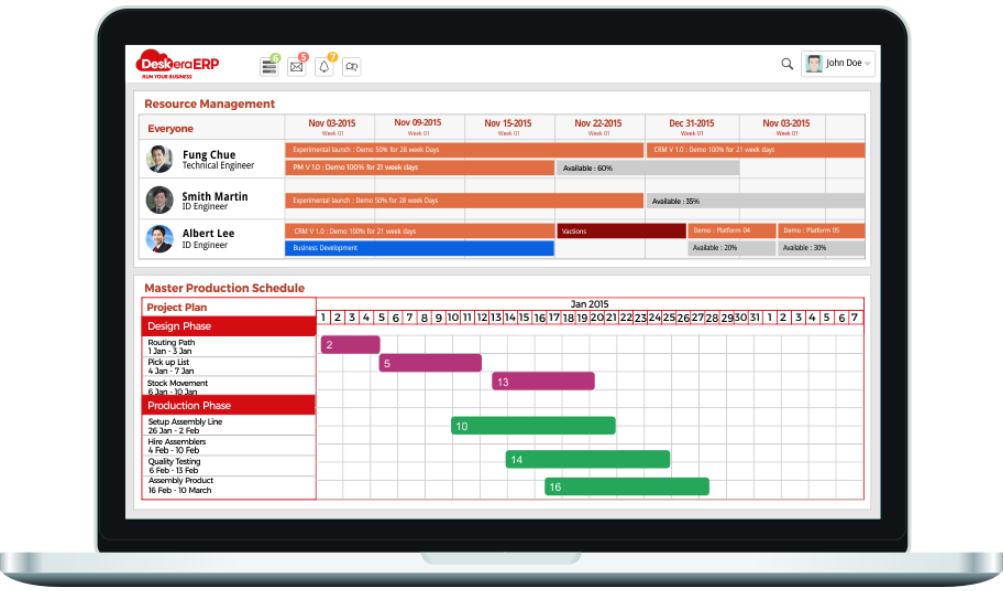
Deskera's integrated financial planning tools enable investors to better plan and track their investments. It can assist investors in making faster and more accurate decisions.
Deskera Books allows you to better manage your accounts and finances. Maintain good accounting practices by automating tasks like billing, invoicing, and payment processing.
Deskera CRM is a powerful solution that manages your sales and helps you close deals quickly. It not only enables you to perform critical tasks like lead generation via email, but it also gives you a comprehensive view of your sales funnel.
Deskera People is a straightforward tool for centralizing your human resource management functions.
Key Takeaways
- Effective leather production requires streamlining processes, reducing waste, and implementing quality control measures.
- Analyzing current production processes and identifying inefficiencies and bottlenecks is a crucial first step towards streamlining.
- Investing in modern equipment and technologies, such as automation, can help optimize resource usage and increase efficiency.
- Automation can be implemented in various areas of the production process to reduce manual labor, save time, and reduce material waste.
- Reducing material waste is essential for minimizing production costs and optimizing resource usage.
- Standardizing processes can help ensure consistency and quality control throughout the production workflow.
- Cross-training employees can increase flexibility and efficiency, allowing for better utilization of resources.
- Implementing quality control measures is crucial for maintaining product quality and customer satisfaction.
- Regular progress monitoring and measurement can help identify areas for improvement and ensure ongoing success.
- An MRP system can help optimize production planning, scheduling, and inventory management for more efficient leather production.
- MRP systems can provide real-time data analysis, improving decision-making and helping identify and resolve issues promptly.
- Implementing an MRP system can lead to improved productivity, reduced costs, and increased profitability in the leather production industry.
Related Articles
